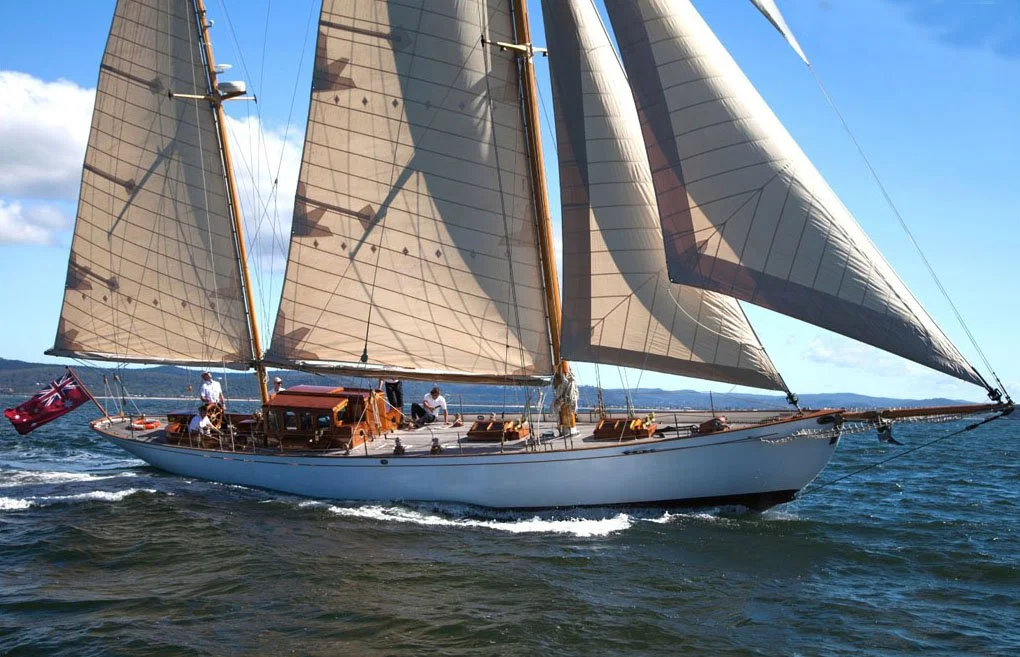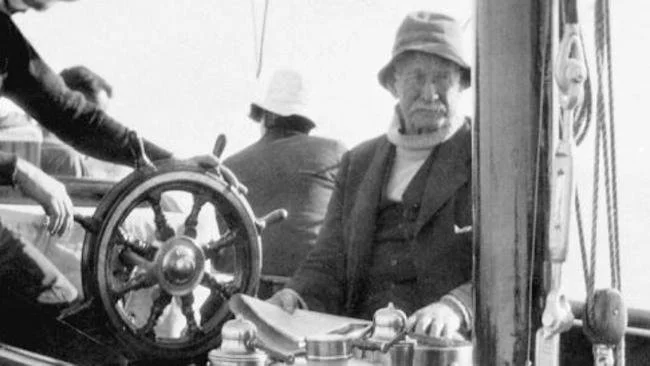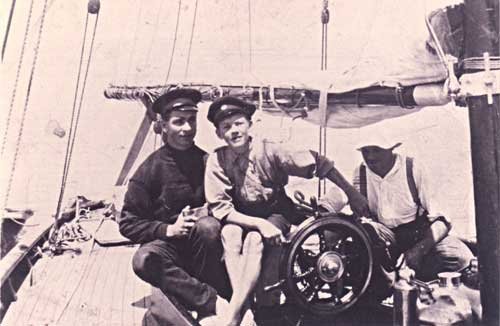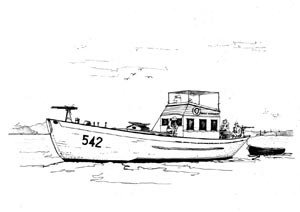The Great Gatsby Yacht
By Malcolm Lambe
As a teen in the sixties I was crewing on a 25ft Colleen class yacht out of The Royal Prince Alfred Yacht Club at Newport, Pittwater and after the races would sometimes take the lemonade the skipper would buy me and walk out on the berths to drool over the yachts. “One day” I’d say to myself.
One large timber boat in particular had my eye. A real beauty - a sixty foot 1924 Nicholson design ketch called HURRICA V that seemed to be in a constant state of repair. At the time it was owned by one of the Shaws who had E.J. Shaw & Sons sand and gravel business on the main road at Mona Vale.
“To young Gatz, resting on his oars and looking up at the railed deck, that yacht represented all the beauty and glamour in the world.” - The Great Gatsby.
Quite. And yes - this is the yacht featured in Baz Luhrmann’s 2013 movie “The Great Gatsby”. They spent a day shooting footage of the yacht sailing off Lion Island. In the end only fifteen seconds were used and it cost the production company $15,000 for the days charter.
HURRICA V – the magnificent Edwardian classic is a wooden cruising yacht of a design by C. E. Nicholson of the famous English firm Camper and Nicholsons. Built in 1924 at the Berrys Bay, Sydney yard of W. M. Ford Boatbuilders at a cost of £10,000 for William Oliver - a wealthy wool grazier of Melbourne. It was one of three yachts he owned at the time – including a 55ft racer. “To hell with sheep - I’d rather be sailing” he might have said.
HURRICA V
Charles E Nicholson 60 ft Ketch 1924
Designer: Charles E Nicholson
Builder: W M Ford Sydney
Date: 1924
Length overall: 71 ft 4 in / 21.75 m
Length deck: 59 ft 1 in / 18 m
Length waterline: 42 ft 8 in / 13 m
Beam: 14 ft 1 in / 4.3 m
Draft: 7 ft 7 in / 2.3 m
Displacement 32.5 Tonnes
Construction: Browns Pine carvel planking on spotted gum frames
Engine: Perkins M 115T 115 HP Diesel
HURRICA V was constructed of Browns Pine carvel planking, copper-roved with Spotted Gum frames. Kauri (Agathis Australis) decks 38mm (1.25″) with thick outer edge of deck and bulwark caps in teak.
Bill Oliver was already 71 when the yacht was delivered to him in Melbourne as a mainly private vessel for cruising Wilsons Promontory and Bass Strait. Up until 1938 she was fastidiously maintained by three live-aboard paid hands and was the stand-out yacht at The Royal Yacht Club of Victoria.
William Oliver aboard the yacht in 1927
One of the paid hands was Selim Nurminen – a Finn who had been a crewman on a square-rigger. He spent 11 years working for Bill Oliver on Hurrica and eventually at St Kilda Yacht Club. There’s a pic of him on the helm IN AN EARLIER SWS ARTICLE.
By 1941 her owner had been ill for some years and had let the boat go. She was sold in a dilapidated state for £2000 to Will Stuart of Darling Point, Sydney. He had her internal layout remodelled and changed the rig from gaff to Bermuda with the removal of the mizzen mast. Her hull was also copper-sheathed at this time (more on copper sheathing here).
In 1943 she was requisitioned by the Royal Australian Navy. At that time she had a two-oil lamp brass binnacle compass, bronze stanchions, a Gardner diesel engine and a 6V single cylinder petrol genset. The internal layout was changed again and her rig and sails removed. A wheel house, flybridge and sponsons were added along with a dirty great machine gun mounted on the foredeck and further guns aft.
She was further armed with depth charges. A new and more powerful Superior diesel engine, 32V genset and radios were installed and she was painted Navy Grey and renamed HMAS 542 STINGRAY. She served mostly in New Guinea and Milne Bay as a search and rescue vessel. She was paid off at Milne Bay in 1946 and steamed to Brisbane and then towed to Sydney – suffering damage along the way.
After the war Will Stuart bought her back from the Navy for £1650. She was in a poor condition. Engine and genset were seized, stem splintered and broken above the waterline, sponsons loose, damage to decks and bulwarks. He had her restored to her pre-war configuration then sold her in 1947 as he’d bought the larger Fife ASTOR
HURRICA V ’s new owner, Clifford Crane of Wahroonga, Sydney - a member of RSYS, Chairman of AMP & AGL and on the Board of CSR used her on Sydney Harbour and Pittwater. She was moored off Malcolm Campbell’s boatshed at Rose Bay for a couple of years. He had the hull re-sheathed in Muntz metal- also known as “yellow metal” - an alloy composed of 60% copper, 40% zinc and a trace of iron. Muntz was two thirds of the price of copper sheathing.
The boat had a new teak deck laid, a new 65hp Perkins installed and a timber dodger built over the cockpit.
When Crane died HURRICA V was sold to E John Shaw Jnr of Shaws Sand & Gravel at Mona Vale. Shaw swapped three residential blocks and two industrial blocks of land plus $3000. He used her as a private vessel on Pittwater and in 1963 cruised to New Caledonia and The Loyalty Islands - weathering a cyclone.
John Shaw and his wife Jan lived aboard at RPAYC in 1965 when the boat underwent an extensive refit while a starry-eyed, lemonade-drinking yoof – moi - was admiring her lines.
Another refit followed in 1982. Shaw had the interior stripped ready for yet another refit the following year when the recession hit and the vessel was left for years on a mooring in a near-derelict state. It was a crying shame.
In 1986 Gary Dover, a builder of Sylvania Waters, Sydney bought her for $40,000 with only the diesel engine inside. He had her rebuilt from the bare hull specifically for charter work out of Port Stephens, NSW and renamed her THE GIFT. She ran aground a couple of times during his ownership and was sold with deadwood damage but in fair condition.
In 1997 the boat was sold to Patrick Silver - a retired banker of Avalon, Sydney. He used her as a live-aboard and she was taken back to her original name HURRICA V and underwent several cruises - once to Fiji. But yet again the boat fell into a poor state and was sold to Annabel & Peter Gunns in 2001.
The Gunns restored HURRICA V over eight years at a cost of several million by the renowned 100 year old boatyard, Norman R Wright & Sons on the Brisbane River in Queensland - who also did the initial restoration on CAMBRIA
The yacht was stripped back to a shell and ribs and planking repaired. All the hull fastenings were replaced, as were the massive bronze keel bolts.
New masts and spars were built from laminated hollow spruce by the UK’s premier wooden mast maker – Collars - and shipped to Sydney. The original engine was replaced and the new donk fitted with a v-drive so it no longer had to sit in the middle of the saloon.
Steve Gunns also adjusted the interior. Originally the yacht had the galley in the bow, a single berth owner’s cabin and the crew berths in a crawl space under the cockpit.
The redesign saw two berths in the coach house and three double cabins and two bathrooms below. The galley was brought aft and fitted with cleverly hidden modern aids such as a freezer, a fridge and a microwave oven. Gunns sourced Italian made 'oil lamps' that matched the originals but which provide light from low-drain LEDs. "I wanted the interior of the yacht to look like a gentlemen’s club," Gunns said.
Norman Wright & Sons recommended fiberglass sheathing underwater on the hull but the Gunns decided, after much discussion and cries of protest from the classic yacht fraternity, to remove the copper sheathing, spline the planks and replace the copper.
Following her restoration HURRICA V returned to her home port in February 2011 and sailed Bass Strait to take part in that year’s Wooden Boat Festival.
Steve Gunns put her up for sale five years later and wrote on her brokers listing -
“I can sail my Sydney-based classic Nicholson 60, HURRICA V single-handed, and I repeat here that I am confident I could, on my own, sail the 1,200 miles from Australia to New Zealand. That said, HURRICA V was planned as a short-handed family cruising vessel capable of crossing oceans, and, while far from the same, I have regularly sailed alone the 30-mile leg to our favourite cruising grounds where I go early to get a good anchorage before the family arrive later.”
The primary, but far from the only, decisions in my restoration plan were what amendments might be needed to Nicholson’s sail plan to improve sailability and living aboard. I wanted a usable family yacht to sail with my wife Annabel and our young boys, without crew. But our vessel had to look good and portray the spirit of the 1920s, if not as an exact reproduction. I could hardly see Annabel enjoying a day out with friends on the harbour when I suggested that we hoist our gaff ketch main followed by the jack-yard topsail – I would need to learn to swim! I daren’t even think about it if we had a cutter’s 40ft boom.
I researched the Camper & Nicholson records at Greenwich, UK, in which HURRICA V of 1922 is noted as Yard No 315. A short trawl through the archive to Yard No 318 and I had my answer. Designed just three months later, BARBARA was a 48ft bermudan yawl retaining a long and low sail profile with triple headsails on a HURRICA-length bowsprit. This was to be our template, and, being designed within months of HURRICA’s design, BARBARA’s sail plan could easily have been intended for us.
Sails and Sailing
HURRICA’s new sail plan features a five sail wardrobe, meaning that each of the three headsails is tiny, making handling easy. As wind increases the headsails are dropped from the front to rear; at 15 knots the jibtop is lowered first and lashed, then the jib and staysail are furled as wind increases. Different sail combinations work in heavy wind depending upon the wind angle and sea state, but too much wind generally loads up the mizzen creating excessive weather helm, so this can often be the first sail lowered.
However, a small idiosyncrasy now comes in. Neither the crew on the sheet, nor the helmsman can see the jib and jibtop as they are concealed behind the staysail. Crew can be sent forward to call the sheeting, but it is easier, especially short-handed, to mark the sheet so the sail can be positioned reasonably accurately without going forward.
Crossing Bass Strait. Image Steve Gunns
Runners
The runners were originally tensioned by rope and tackle (but I had no intention of reverting to the use of tackle). All options for winches were tested and the winch handle arc proved remarkably space-devouring. Although I had been warned against Highfield levers, they became the next possibility. Highfield levers with a narrow fixed platform solved the problem but had to be custom-made – the natural bronze does enhance the historic impact.
Nicholson had the runner levers designed at such a wide angle at the maximum beam amidships, that the boom can tack effectively with both runners simultaneously engaged. The mizzen is similarly set at the maximum available beam, and the warnings against having runners have proven baseless.
No Vangs
HURRICA V has no vang. Without a boom vang and with sheets eased, the aft end of the boom lifts, while HURRICA’s boom length has been carefully designed so that as this happens, it clears the mainmast backstays and the mizzen mast forward lowers. During a tack, but especially a gybe, the lifting boom end allows the leech to open and subsequently eases pressure on the sail. Once the main is set on the new tack, it is still open-leeched until sheeting re-applies the pressure. This is effectively a de-powering mechanism that makes gybing easy even in heavy weather – more later!
To save potential damage to the coachroof if a halyard is dropped inadvertently, permanently lashed topping lifts support both booms.
Rigging
Instead of hemp ropes and wire, HURRICA V now has comfortable Dynex Dux high strength boom strops with the exposed grey core appearing as wire unless examined really closely. Where the cores are not exposed, all ropes have white casings that cause minimal abrasion – they’re kind to hands and are gentle against the varnished booms. The virtually stretchless Dyneema halyards require little or no adjustment during a day’s sail. Halyard tails travel to their winches via jammers, making sail hoisting controllable and easy. The visual effect of jammers is definitely un-classic, but the black finish has been diluted by a covering of an exterior film the same colour as the Douglas fir masts.
Winches
The main and mizzen sheet cockpit winches are both adjacent the helm for safety, and both horses (travellers) are clear of the cockpit for comfort (unlike the original layout had the main horse across the front of the cockpit). All headsails and the mainsail are hoisted on discrete electric Andersen winches on the side of the mast, while the headsails sheet to over-sized bronze deck-mounted.
With a wide, flush, mast-to-mast working platform, and self-tailing winches, it is possible for a single crewmember to cover the entire sector between the masts, greatly reducing the number of crew required.
Hull, Keel and Motion
HURRICA V has a classic but beamy hull form with shallow draft and heavy displacement. The high level of form stability and powerful hull results in a stiff and stable yacht. These characteristics provide a gentle, loping motion at sea and, assissted by high bulwarks, a confident crew can work securely without fear of being pitched overboard.
The 40ft long keel allows a true course to be held even in rough and quartering seas but, while the long keel holds course, this makes tacking and gybing quite slow. The slowness to change direction could at first appear a distraction, however that slowness becomes a friend as it allows a leisurely tack giving the crew with more time to function.
Steering
The 1920s aft-facing reverse-style steering can appear confusing and illogical, but is very effective and not difficult to master. HURRICA is never steered with the helmsman forward of the wheel, but is steered from sitting behind the wheel on either side of the steering box. The further outboard he is, the better the helmsman can see both the sails and the sea ahead, as, on the centreline, a the mizzen obscures the line of sight. We find the vessel is more often than not sailed on the autopilot on electronic charts and, if necessary, steering is available away from the cockpit by remote control.
An extremely un-classic bow-thruster has been fitted. I spoke to many parties about this inclusion and concluded that a die-hard would be disgusted, but any owner wanting a friendly usable yacht would welcome it, especially being below the waterline where it remains out of sight. Reversing any classic can be a fearful experience, and exiting my berth was always a concern. I now drive onto a forward springer if necessary to give some angle out, plod backwards with the helm fixed onto the centreline and push the nose to port or starboard with the thruster to steer. It takes a little getting used to but once mastered reversing is no longer an issue.
Sailing HURRICA V
Day sailing on any classic, if properly planned around course, current and wind direction, is unlikely to involve many tacks or gybes, especially in high winds – because then, surely, you would stay in port. With a reaching course planned for the day, even fewer tacks or gybes would be needed. It took a while to master the manoeuvres, but the following is the benefit of my experiences.
At the berth, hank on the jib topsail and lash it to the bowsprit netting. Remove boom crutches to under-cockpit storage; boom weight is now taken on the permanent topping lifts. It is time to reverse steer from the berth with control provided by the bow-thruster.
Whichever will be the windward runners, are tensioned while the leeward runners are loosened to open the hoisting slot. One at a time, headsails are unfurled, halyards tensioned, sails sheeted and the helm eased away. You are now sailing.
Tacking
If necessary, steer slightly higher into the wind or haul in the main a little to allow the leeward runner to be tensioned with a quick flip of the Highfield.
Pre-tack
HURRICA’s sails can be heaved out of line while the keel comfortably retains course, (unlike a modern fin-keeled yacht). So the headsails – with no overlap – can be hauled hard on the windward sheet with the clews tending into the wind. A tacking angle of about 80 degrees, (while not particularly effective going into the wind), allows the crew those few extra seconds to prepare. When it is time to take up on the new sheets, there is nominal drag, the sails are in control, and headsails can be hauled very close in (and sometimes fully sheeted without resorting to the winch) before the tack is complete. If uncomfortable, furl the jib and even the staysail so the jibtop is the only sail left to tack. Main and mizzen will look after themselves on the horses.
Slowly at first, the steering of the tack will accelerate and experience is needed to under-correct as the tacking momentum will otherwise carry into a reach on the new leg if not careful. But the option of a free pair of hands can be available by setting the autopilot to a time and angle tack mode. When settled, the headsails are finish-trimmed and you are climbing to windward. You’ve tacked with no damage done.
Gybing
Gybing has a scare factor that has proved to be over-rated. When gybing in strong winds, the course is easily held under autopilot, while the main is power-winched to the centreline. HURRICA will hold course easily and, once the main is centred, all pressure goes off. The ability to hold a course greatly eases pressure on the crew and the tracking ability turns what could be a scary gybe into a comfortable sailing operation. On a recent trip downwind with full main and jib in the black of night, the breeze built very quickly to 30 knots apparent and caught us out. We obviously needed to reduce canvas urgently, but the thought of heading back to windward into thumping seas to lower the main was not exciting. So, downwind in a near gale, with three at the mast, we “simply” centred the main and heaved the halyard using the flogging to help it loose off the shrouds. Once gybed, the reefing line was taken in as the sheet was eased. I could not believe it worked and congratulated the crew, but congratulations should also go to the yacht: its level work area around the mast, its tracking ability and the powerful systems making such a manoeuvre possible. HURRICA V can hold her mast high.
Three competent crew could easily handle HURRICA V in any weather, on any course, while we have met our target to be a family yacht well capable of sailing two-handed in a moderate breeze.
Now, if you want the best ride of your life, try sailing to windward. HURRICA V is not particularly effective upwind, but effective or not, sailing to windward in 20 knots on a thundering and powerful classic gives a mind-blowing sensation of power. You won’t forget it.”
HURRICA V is now lying in California at Westpoint Harbor, Redwood City, in front of a new restaurant of the same name, having been bought by the marina owner for a reputed $1.85M. Like CAMBRIA - lost to overseas interests. A very great pity she’s still not in Australian hands on Australian shores.
“...that yacht represented all the beauty and glamour in the world.” - The Great Gatsby.
References-
http://blog.sandemanyachtcompany.co.uk/hurrica-v-a-lesson-in-design-and-simplicity
https://australianwoodenboatfestival.com.au/hurrica-v-a-stylish-lady
https://classicyacht.com.au/the-locker/cyaa-magazine-archive/#flipbook-df_2879/1
https://www.latitude38.com/lectronic/tradition-and-sailing-redwood-creek-and-westpoint-harbor














